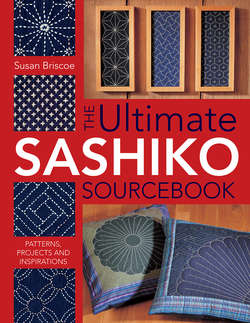Читать книгу The Ultimate Sashiko Sourcebook - Susan Briscoe - Страница 5
На сайте Литреса книга снята с продажи.
INTRODUCTION
ОглавлениеSashiko is the magical country stitching of northern Japan. Pronounced ‘sash(i)ko’ (the ‘i’ is almost silent), it means ‘little stab’ or ‘little pierce’, an accurate description of the stitching action. Originally invented for warmth and thrifty recycling, strengthening work clothes and household goods, sashiko combines country style with intricate designs – all made with simple running stitch.
Handed down from mother to daughter, from hand to hand, in farming and fishing communities, practical and decorative sashiko created a unique style. White running stitches on indigo blue recall snow falling around the old farmhouses, while inside, women stitched beside the irori hearth, conjuring patterns from thread and cloth.
Most old sashiko has all-over designs of varying complexity, adapted from popular patterns. Mastering these patterns is the key to really understanding sashiko – it’s not just stitching Japanese designs in outline! Sashiko sometimes includes motifs or a kamon(family crest) or has larger pictorial elements worked in running stitch.
I first saw sashiko stitching in 1991 in Yuza-machi in the western Shonai district of Yamagata Prefecture, Japan (a Prefecture is like a large county). I was given two pieces – a business card holder and a small mat. I was fascinated but, as a busy English teacher, I didn’t have time to learn how to stitch sashiko properly. When I returned for the millennium New Year celebrations I wanted to learn.
Mayor Ken Onedira introduced me to local sashiko teacher Chie Ikeda, who taught me to sew hitomezashi, the small stitch patterns traditional to Shonai. My friends took me to see many inspiring works, old and new. My former neighbour, Reiko Domon, was also stitching sashiko and teaching the local quilt group. Old and new friendships finally led to the ‘Magic of Sashiko’ exhibition at the inaugural Festival of Quilts in Birmingham, England in 2003. Chie, Reiko and seven sashiko experts made the trip and we taught more than 150 visitors over four days, proving that stitching is a universal language. Sashiko was described as ‘fascinating’, ‘therapeutic’, ‘relaxing’ and even ‘addictive’!
Nowadays, we don’t have to be thrifty to stitch sashiko. The great variety of traditional patterns will inspire your creativity – there are over 100 patterns in this book. The book starts with a brief but fascinating history of sashiko. This is followed by a section describing everything you need to know to get started – the materials and equipment needed, how to mark designs and work the sashiko stitches. There is then a selection of easy projects to whet your appetite. Favourite traditional patterns appear in the extensive Pattern Library beginning on page 58 and, for the first time in an English-language publication, the dense hitomezashi patterns stitched in Shonai (pages 96–109). The projects and the patterns in the library start with the easiest, so you can work your way through them to become a real sashiko expert. ‘Magic of Sashiko’ exhibition highlights are included in the Inspiration Gallery beginning on page 110.
As a sashiko teacher in the United Kingdom, I have been asked many questions. I hope this book will give you the answers, with much pleasurable stitching along the way. Reflect the spirit of rural life with sashiko’s classic combinations of indigo and white or echo the colours of the landscape in your creations as you capture the magic of sashiko in your work.
The ‘Magic of Sashiko’ team at the Festival of Quilts, England 2003. The large panel behind us is called ‘Noshi’ by Keiko Hori, 1988 (see picture opposite) and the long narrow panel in the background is Shonai Sashiko Sampler by Cheiko Hori – all 13 yards of it! (See also Inspiration Gallery, page 113.)
‘Noshi’ wall hanging by Keiko Hori, featuring patterns traditional to Yuza-machi. All the thread is creamy white, the illusion of colour created entirely by the varying density of the patterns. From left to right, below the bundle centre are: jūjizashi, sanjūkakinohanazashi, kusari jūjizashi, asanoha, kakinohanazashi and sorobanzashi (pages 97, 101, 98, 72, 100 and 109). The appliqué was made with pieces of antique cloth from Keiko’s collection before the sashiko was stitched, producing subtle colour accents. Old sashiko was patched from the back before stitching – the appliqué echoes and develops this tradition. See page 94 for more about noshi.
